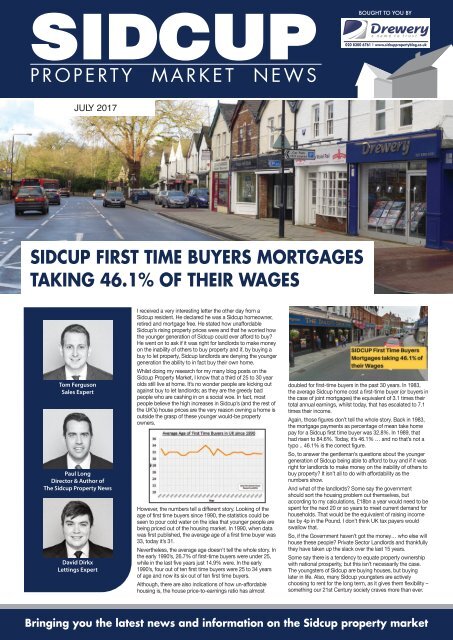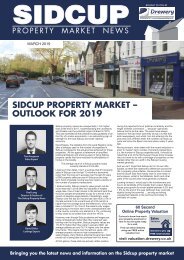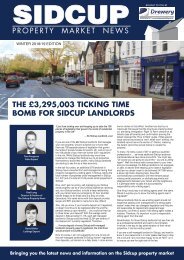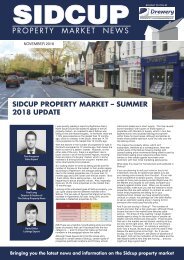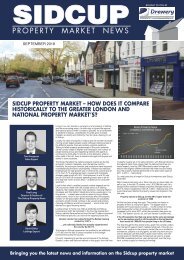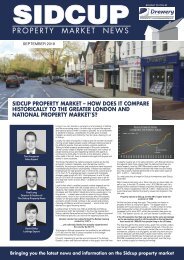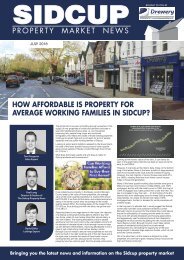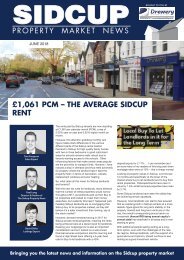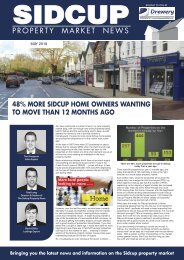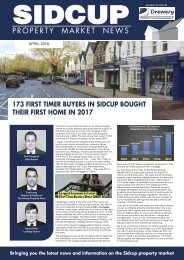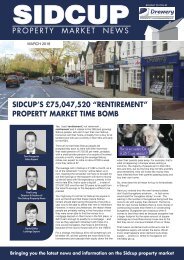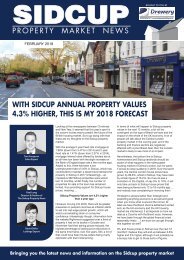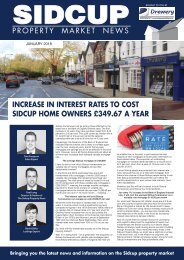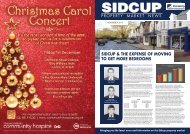SIDCUP PROPERTY NEWS - JULY 2017
Drewery Property Consultants Keeping you informed of properties available on the market and industry related articles.
Drewery Property Consultants Keeping you informed of properties available on the market and industry related articles.
You also want an ePaper? Increase the reach of your titles
YUMPU automatically turns print PDFs into web optimized ePapers that Google loves.
<strong>SIDCUP</strong><br />
<strong>PROPERTY</strong> MARKET <strong>NEWS</strong><br />
BOUGHT TO YOU BY<br />
020 8300 6761 | www.sidcuppropertyblog.co.uk<br />
<strong>JULY</strong> <strong>2017</strong><br />
<strong>SIDCUP</strong> FIRST TIME BUYERS MORTGAGES<br />
TAKING 46.1% OF THEIR WAGES<br />
Tom Ferguson<br />
Sales Expert<br />
Paul Long<br />
Director & Author of<br />
The Sidcup Property News<br />
David Dirkx<br />
Lettings Expert<br />
I received a very interesting letter the other day from a<br />
Sidcup resident. He declared he was a Sidcup homeowner,<br />
retired and mortgage free. He stated how unaffordable<br />
Sidcup’s rising property prices were and that he worried how<br />
the younger generation of Sidcup could ever afford to buy?<br />
He went on to ask if it was right for landlords to make money<br />
on the inability of others to buy property and if, by buying a<br />
buy to let property, Sidcup landlords are denying the younger<br />
generation the ability to in fact buy their own home.<br />
Whilst doing my research for my many blog posts on the<br />
Sidcup Property Market, I know that a third of 25 to 30 year<br />
olds still live at home. It’s no wonder people are kicking out<br />
against buy to let landlords; as they are the greedy bad<br />
people who are cashing in on a social woe. In fact, most<br />
people believe the high increases in Sidcup’s (and the rest of<br />
the UK’s) house prices are the very reason owning a home is<br />
outside the grasp of these younger would-be property<br />
owners.<br />
However, the numbers tell a different story. Looking of the<br />
age of first time buyers since 1990, the statistics could be<br />
seen to pour cold water on the idea that younger people are<br />
being priced out of the housing market. In 1990, when data<br />
was first published, the average age of a first time buyer was<br />
33, today it’s 31.<br />
Nevertheless, the average age doesn't tell the whole story. In<br />
the early 1990’s, 26.7% of first-time buyers were under 25,<br />
while in the last five years just 14.9% were. In the early<br />
1990’s, four out of ten first time buyers were 25 to 34 years<br />
of age and now its six out of ten first time buyers.<br />
Although, there are also indications of how un-affordable<br />
housing is, the house price-to-earnings ratio has almost<br />
doubled for first-time buyers in the past 30 years. In 1983,<br />
the average Sidcup home cost a first-time buyer (or buyers in<br />
the case of joint mortgages) the equivalent of 3.1 times their<br />
total annual earnings, whilst today, that has escalated to 7.1<br />
times their income.<br />
Again, those figures don’t tell the whole story. Back in 1983,<br />
the mortgage payments as percentage of mean take home<br />
pay for a Sidcup first time buyer was 32.8%. In 1989, that<br />
had risen to 84.6%. Today, it’s 46.1% … and no that’s not a<br />
typo .. 46.1% is the correct figure.<br />
So, to answer the gentleman’s questions about the younger<br />
generation of Sidcup being able to afford to buy and if it was<br />
right for landlords to make money on the inability of others to<br />
buy property? It isn’t all to do with affordability as the<br />
numbers show.<br />
And what of the landlords? Some say the government<br />
should sort the housing problem out themselves, but<br />
according to my calculations, £18bn a year would need to be<br />
spent for the next 20 or so years to meet current demand for<br />
households. That would be the equivalent of raising income<br />
tax by 4p in the Pound. I don’t think UK tax payers would<br />
swallow that.<br />
So, if the Government haven’t got the money… who else will<br />
house these people? Private Sector Landlords and thankfully<br />
they have taken up the slack over the last 15 years.<br />
Some say there is a tendency to equate property ownership<br />
with national prosperity, but this isn’t necessarily the case.<br />
The youngsters of Sidcup are buying houses, but buying<br />
later in life. Also, many Sidcup youngsters are actively<br />
choosing to rent for the long term, as it gives them flexibility –<br />
something our 21st Century society craves more than ever.<br />
Bringing you the latest news and information on the Sidcup property market
21.2 MILES – THE AVERAGE DISTANCE PEOPLE<br />
GO WHEN MOVING OUT OF <strong>SIDCUP</strong><br />
“How far do Sidcup people go to move to a new house?” This was an<br />
intriguing question asked by one of my clients the other week. Readers<br />
of my property blog will know I love a challenge, especially when it<br />
comes to talking about the Sidcup Property Market!<br />
For the majority, the response is not very far. It is much more common<br />
for homeowners and tenants in Great Britain to move across town than<br />
to the next town or county. Until now, it’s been hard to say how many<br />
homeowners and tenants moved from (and to) relatively far away to buy<br />
or rent their new home. However, I carried out some research and<br />
requested some statistics from the Royal Mail. What came back was<br />
fascinating!<br />
Using statistics for the 12 months up to the middle of Autumn 2016,<br />
363 households moved out of Sidcup (DA15), moving an average<br />
distance of 21.25 miles – the equivalent of moving from Sidcup to<br />
Harrow (as the crow flies). The greatest distance travelled was 257<br />
miles – that’s more than 9.5 marathons (when someone moved to<br />
Prudhoe near Newcastle-upon-Tyne).<br />
Considering there were 386 property sales in DA15 in the year and<br />
countless tenant moves, the numbers seems consistent – once you find<br />
a town you like, you tend to want to settle down and if you do move,<br />
you might only move to a different neighbour-hood, or for better<br />
transport links or, to be closer to the school you want to get your<br />
children into, but the likelihood is you won’t travel far.<br />
I then turned my attention to people moving into Sidcup. Using the<br />
same statistics for the 12 months up to the middle of Autumn 2016, 362<br />
households moved into Sidcup (DA15), moving an average distance of<br />
13.25 miles – the equivalent of moving from Sevenoaks to Sidcup<br />
(again as the crow flies). The greatest distance travelled was 232 miles<br />
– that’s the same as nearly 9 marathons (when someone moved from<br />
Ulverston to Sidcup).<br />
I have looked at the data of every person moving into Sidcup and these<br />
have been plotted on a map of the UK. Looking at the map below, it<br />
shows exactly where most people come from, when moving into<br />
Sidcup. As you can see, there are a high proportion of people moving<br />
from the North West.<br />
So, what does all this mean for the landlords and homeowners of<br />
Sidcup?<br />
When an agent markets a property for rent or let, it is vital to know the<br />
tenant or property buyer well, that the properties they are letting/selling<br />
fit those tenants/buyers, so they almost sell themselves. These days<br />
that means not only knowing how many bedrooms, reception rooms<br />
etc., a property offers but the budget buyers and tenants want to spend<br />
on a property in that area as well as where they come from.<br />
The estate and lettings industry loves the mantra “location, location,<br />
60 Second<br />
Online Property Valuation<br />
Curious to know how<br />
much your property<br />
would sell or rent for<br />
but not quite ready for a<br />
visit.<br />
Find out online instantly<br />
using our FREE online<br />
valuation tool.<br />
Sales<br />
Valuation<br />
Click here to get a<br />
FREE instant valuation<br />
visit valuation.drewery.co.uk<br />
location”. I say it might be helpful to factor in where (and how) far<br />
people are moving from, so the property can be sold or let more easily.<br />
Many say knowledge is power and whilst I do enjoy writing my blog on<br />
the Sidcup property market, I also use the information to help my<br />
clients buy, let and sell well. So for example, the information gained for<br />
this article, will enable my team and I to be more efficient in where to<br />
direct our marketing resources to ensure we maximise our clients’<br />
properties sale-ability or rentability.<br />
Current Average Asking Prices in Sidcup<br />
1<br />
BED<br />
FLAT<br />
£270,908<br />
2<br />
BED<br />
FLAT<br />
£336,776<br />
data from zoopla.co.uk using current properties being marketed<br />
2<br />
BED<br />
HOUSE<br />
£367,333<br />
3<br />
BED<br />
HOUSE<br />
£459,164<br />
4<br />
BED<br />
HOUSE<br />
£565,000<br />
For more Sidcup Property News visit: www.sidcuppropertyblog.co.uk
1 IN 6 <strong>SIDCUP</strong> PROPERTIES ARE<br />
LEASEHOLD<br />
There are 23.36 million properties in England and Wales<br />
with 64% being owner occupied and 36% being rented<br />
either from a private landlord, local authority or housing<br />
association.<br />
Over nine out of ten of those English and Welsh owneroccupied<br />
properties are a whole house or bungalow.<br />
Now, most people would assume they would be freehold<br />
– however, of those renting nearly half of rental properties,<br />
44% to be precise, lived in other leasehold apartments<br />
and flats.<br />
It might be wise to quickly explain the difference between<br />
freehold and leasehold. When someone owns the<br />
freehold of a property they own it outright, including the<br />
land it is built on, whilst with a leasehold property the<br />
leaseholder owns the property for the length of their lease<br />
agreement. Leaseholders must pay the person who owns<br />
land (the freeholder) ground rent and other fees. When the<br />
leasehold ends, ownership returns to the freeholder<br />
although the leaseholder can extend the lease or they can<br />
buy the freeholder out, but there are rules and regulations<br />
with regards doing that.<br />
Therefore, it would be safe to assume that houses are<br />
freehold and flats are leasehold .. wouldn’t it? Not<br />
necessarily! Most houses are freehold but some might be<br />
leasehold – usually through shared-ownership schemes –<br />
but more and more new homes builders are selling<br />
houses on a leasehold as well. The protection of the law<br />
afforded to leaseholders who own a flat is massive, but<br />
sadly lacking to leasehold houses sold privately.<br />
Looking specifically at the figures for Sidcup, at the last<br />
count in DA14 and DA15 there were 22,705 properties.<br />
Since 1995, 21,492 properties in DA14 and DA15 have<br />
changed hands and have been sold. Looking further at<br />
those 21,492 transactions in DA14 and DA15 since<br />
1995, using data from Land Registry and solicitors<br />
practice My-Home-Move, 17.30% have been leasehold<br />
(higher than the national average of 15%).<br />
The issue comes when builders sell the freehold<br />
separately to an investment company without informing<br />
the lease holder – which they are legally allowed to do<br />
without telling the leaseholder. In England and Wales, the<br />
“right of first refusal” to buy the freehold is written in law<br />
to leaseholders of flats i.e. the freeholder must offer it to<br />
the leaseholders of all the flats of the building first), but<br />
not leaseholders of houses.<br />
.. and this is the point I am trying to get across. If you are<br />
buying a new home and it’s a house (i.e. not a flat) –<br />
please check very carefully indeed whether its freehold or<br />
leasehold. If it is a leasehold, whilst you do have rights,<br />
they are not as strong as for those people buying a<br />
leasehold flat. I appreciate I am only talking about a very<br />
small percentage of the property market, but potentially<br />
this could end up costing thousands of pounds to those<br />
affected.<br />
Current Average Asking Rents in Sidcup<br />
However, I am concerned about a few new homes<br />
builders selling new houses (not flats – houses) as<br />
leasehold. There has been a growing (yet small) trend for<br />
new-build houses to be sold as leasehold in recent years.<br />
While not all house builders use this model, those that do<br />
maintain it helps make developments financially viable.<br />
1<br />
BED<br />
FLAT<br />
£817pcm<br />
2<br />
BED<br />
FLAT<br />
£1,206pcm<br />
data from zoopla.co.uk using current properties being marketed<br />
2<br />
BED<br />
HOUSE<br />
£1,236pcm<br />
3<br />
BED<br />
HOUSE<br />
£1,392pcm<br />
4<br />
BED<br />
HOUSE<br />
£1,642pcm<br />
For more Sidcup Property News visit: www.sidcuppropertyblog.co.uk
c?U PU ?cL22 PUU 9U &9 09U êèéî<br />
«sªˆ ȱ ȾÍÂÈ ˜« »¾±»ˆ¾ÈÝ Â˜«ˆ éñìî<br />
ªs¢ˆÂ Í »s¾È˜Í¤s¾¤Ý »¤ˆsˆ„ s~±ÍÈ ±Í¾ s×s¾„ ˜Â È–sÈ È–ˆ ט««ˆ¾ ˜Â<br />
ffd–sÈ<br />
~Ý È–ˆ »Í~¤˜ È–¾±Í’– ±«¤˜«ˆ ‘ˆˆ„~s¢ ‘¾±ª ¤˜ˆ«È ¾sȘ«’ s«„<br />
„ˆÈˆ¾ª˜«ˆ„<br />
È–ˆ –s¾˜«’ ±‘ ÍÂȱªˆ¾ ˆ¾Ö˜ˆ ˆÜ»ˆ¾˜ˆ«ˆÂý 8s«Ý ¤˜ˆ«È –sÖˆ<br />
È–¾±Í’–<br />
±Í¾ ˆÜ»ˆ¾˜ˆ«ˆ s«„ »sȘˆ«ˆ ˜« –ˆ¤»˜«’ È–ˆª ȱ ˆ¤¤ ±¾ »Í¾–sˆ s<br />
»¾s˜Âˆ„<br />
s¤¤’ˆ«ÈÂü±üÍ¢ s×s¾„ ‘±¾ ÍÂȱªˆ¾ ˆÜ»ˆ¾˜ˆ«ˆ<br />
»¾±»ˆ¾ÈÝø ~ÍÈ s¤Â±ø s«„ È–˜Â ˜Â ¾Í˜s¤ ‘±¾ ÍÂø È–ˆÝ –sÖˆ »¾s˜Âˆ„ ±Í¾ –±«ˆÂÈÝýff<br />
Isͤ 2±«’ m˜¾ˆÈ±¾ ‰ ÍÈ–±¾ ±‘ U–ˆ P˜„Í» I¾±»ˆ¾ÈÝ 9ˆ×Âü


